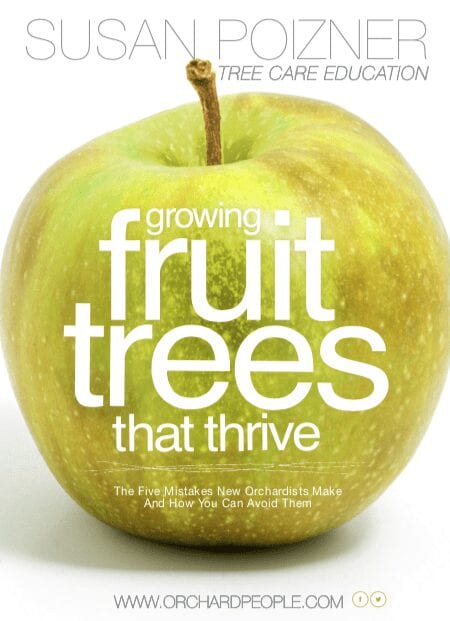
There are many ways to train or weigh down fruit tree branches, including methods that are really cheap or almost free. But if you do want to spend a little money, one of the easiest and effective ways to train apple branches (and this can be used on other types of fruit trees too) is to use apple bands.
In this article, you’ll learn what apple bands are and how to use them from Ron Perry, retired Professor Emeritus of Horticulture at Michigan State University and author of Espalier Fruit Plantings for Northern Gardens: Creating Fruit Trees as Art. This is Ron‘s favorite apple tree training method and he uses it for high-density plantings like tall spindle as well as for freestanding trees.
Let’s dig in!

Why Train Apple Tree Branches?
Do you want your apple tree to produce more and better quality fruit? Training apple tree branches, which means guiding the tree’s side branches to grow horizontally rather than vertically, increases productivity for both high-density plantings and freestanding trees.
Horizontally oriented branches are more likely to produce fruit because this orientation changes the way hormones and carbohydrates are distributed throughout the tree. Here’s why:
- When branches grow vertically, various plant hormones, including auxins, congregate at the growing tip of the branch. Those auxins tell the branch to focus its energy on lengthening from the terminal bud. And so the lateral or side buds on the branch, which have the potential to develop flowers and fruit, don’t get much energy to grow.
- In contrast, when branches grow horizontally, those auxin hormones spread more evenly along the branch. In this case, the lateral buds will also get a good share of the branch’s energy and that encourages the development of flower buds which will eventually develop into fruit.
- In horizontal branches, carbohydrates produced through photosynthesis are also distributed more efficiently. So instead of the last bud of the branch (called the terminal bud) getting all the energy, all the buds will access the energy they need and some of that will go towards flower and fruit development.
So, simply by gently bending and tying down a flexible, young branch, you’ll help it to become more fruitful! It’s just a little work but the benefits can be huge.

What Are Apple Bands?
In our post on training and weighing down fruit tree branches, I explore a number of free or inexpensive branch training methods. In it, expert grower Ron Perry said using apple bands is his favorite method!
Apple training bands are UV-resistant stretchy bands that can be used on their own or attached to each other to lengthen. You will loop the band around the young apple tree branch that you want to train, and then hook it onto the tree’s trunk or onto another branch.
Other apple tree training methods can damage your tree’s bark, causing wounds that can make the tree vulnerable to pests and diseases. But apple training bands are wonderful because they are stretchy so they won’t cut into or girdle the branch. That’s why apple bands are a safer option.

Fruit Tree Care Newsletter
Sign up for our monthly newsletter and we will send you our eBook “Growing Fruit Trees That Thrive.” You can unsubscribe at any time.
Where to Get Apple Bands
Right now, Peach Ridge Orchard Supply in Sparta, MI supplies apple bands in small quantities and tougher, long lasting tab bands in large quantities only. In Canada, you can reach out to Silver Creek Nursery in Ontario as they may be supplying these products soon.

Step-by-Step Guide to Using Apple Bands for Central Leader and High Density Trees
- Understand the Basics: When working with central leader (CL) trees, focus on developing a strong framework that can support the tree’s full crop weight without external support. In the early years, prioritize building this structure, even if it means sacrificing some fruit production. For high-density (HD) orchards, the goal is to build a framework and let the dwarfing rootstock produce as much fruit as possible. This involves allowing many branches to develop and managing their growth. (You can learn all about fruit tree pruning structures in our on-demand, online course Fruit Tree Pruning Masterclass. )
- Timing is Key: Start training your shoots when they reach about 8 inches (20 cm) in length. For both CL and HD trees, the best time to bend branches down is during the flower bud differentiation period, from late June to mid-late July in the Northern Hemisphere. Bending branches during this window will influence the tree’s hormones and carbohydrate distribution, encouraging fruiting flower buds and spurs to form.
- Choose the Right Tools: Use “apple training bands” from orchard supply stores. These bands are partially UV tolerant and will hold branches at the desired angle until the branch lignifies (hardens off). For longer branches, you may need to double the length of the band by looping two or more bands together.
- Attach the Bands: Attach the bands to the tree trunk or a support stake that is at least 12 inches (30 cm) below the targeted branches. This setup creates a right triangle with the band as the hypotenuse. Select the shoot you want to train and place it inside the loop of the band. Be careful not to break the shoot! Check your band setup after about 30 minutes to ensure the bands are staying put and make any adjustments if needed.
- Adjust for Different Tree Sizes: For central leader trees on semi-dwarfing rootstocks, you can use the same approach with a few tweaks. Lengthen the bands by looping more together or use longer “pear bands” (8 inches/20 cm). Add more strands of loops if you need additional tension to control the branch angles.
If you are using the tough, long-lasting Tab Bands, you can remove and reuse them once the branch has hardened off. This may take a month or two. If you are using the thinner apple bands, these are biodegradable and break down over time so you don’t have to remove them.
Both options give you an easy and effective way to train apple tree branches!
Happy growing!
This page includes affiliate links. Orchard People may receive a small commission if you make a purchase. The funds will help support the creation of free resources including our blog, YouTube channel and podcast.

Susan Poizner
Director, OrchardPeople.com Fruit Tree Care Education
Learn more about Susan on the about us page.
#Effective #Train #Apple #Branches #Apple #Bands




